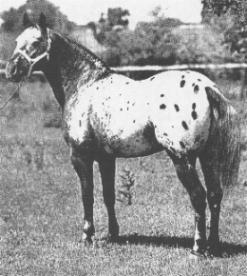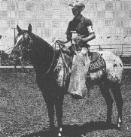|
RUSTLER BILL Appaloosa Stallion Registration: ApHC #F-3372 |
 |
||||||
|
The Company You Keep The Matador Many of the Matador's horses were descendants of Sheik (AQHA P-11), bred by horse breeding legend, Coke Roberds. The palomino (or grullo) Sheik was sired by Peter McCue and out of Coke's mare, Pet. Pet was sired by Old Fred and out of a daughter of the Thoroughbred stallion, Primero, and used as a buggy mare. Sheik was a part of Colorado horse breeder Marshall Peavy's breeding program for a few years, before being purchased by the Matador. Emmet Roberds, Coke's brother, was a manager for the Matador during this time and was instrumental in Sheik being purchased by the Matador. Matador Dun, sired by Sheik, was shipped to Murdo, where he was bred to several of their good Indian mares. One of these mares, Cheyene Gold, F-2671, produced four full brothers, the first being Rustler Bill, F-3372. Cheyene Gold The Indian Bureau purchased several good Appaloosa stallions to be used in a program aimed at upgrading the South Dakota reservation horses. The Thompson-bred stallion, Painter, ApHC F-8, and several Starbuck leopards were included in this program. Cheyene Gold, foaled in 1951, resulted from this improvement program. But, the Appaloosa blood was reported to have been in the tribal horses long before the introduction of the Remount stallions to that area. Kenneth West of Eagle Butte, South Dakota, bred Cheyene Gold to the Zebra Dun Quarter Horse, Matador Dun in 1953. On March 15, 1954, Rustler Bill was foaled on the Cheyenne River Indian Reservation at Eagle Butte. Continuing this same nick produced Chancie Mandan, 1581, in 1955; Cheyenne D Bill, 5959, in 1958; and Wrangler Bill, 5958, rounded out this quartet of full brothers in 1959. While all four brothers amassed impressive show records, none come close to their older brother as a halter horse, performance horse, and sire of winners. A Force To Be Reckoned With
Later that year, December 1958, Fred Wimberly of Fort Worth, Texas, purchased Rustler Bill for his 15-year-old son David to train and show. (In 1959, Fred Wimberly and Bob Thompson, as partners, bought Rustler Bill's dam, Cheyenne.) Young David Wimberly and Rustler Bill turned out to be a Texas duo that blazed through the show circuit, winning at all levels in both halter and performance. It was in their first show at the Fourth International Appaloosa Horse Show in San Antonio, in 1959, that a profound statement was made when Rustler Bill placed second in aged halter stallions. In that class Bright Eyes Brother was first, Joker B. was third, while Navajo Britches, 1958 National grand champion stallion, was fifth. What about "the company we keep?" From his high-classed starts in 1958 and 1959, Rustler Bill and David Wimberly didn't slow down. He stood grand two years in a row, 1960 and 1961, at the Houston Fat Stock Show. At the 1961 Southwestern Exposition and Fat Stock Show in Fort Worth, Texas, first-place aged stallion and grand-champion was High Spot (grand sire of hall of famer, High Sign), while Rustler Bill was second-place aged stallion and reserve grand-champion. Some others in the class; High Hand, third; Little Britches K., fourth; and Top Hat H., fifth. At this same show, an indication of things to come was Rustler Bill's oldest son, Billy Tom, winning the two-year-old stallion class. While the tandem of David Wimberly and Rustler Bill were winning at halter, they were also tearing up the performance classes. At one Meridan, Texas show in 1960, Rustler Bill took on the stars and was first in aged stallions, first in senior reining, first in the reining championship, second in senior cutting, third in the rope race, fourth in trail, and sixth in the barrel race. The 1960 Texas show season (28 shows throughout the state) wound up with Rustler Bill finishing second to Tejas Punto in aged stallions, and sixth overall at halter; third in cutting (behind Mackey's Pride and Double Five Domino); and third in overall performance (behind Pancho A and Chief of Swan Lake). Not bad for a teenage trainer and rider. In 1961, Rustler Bill and David Wimberly eased off the show circuit a bit, but overall managed to garner 31 grand championships at halter and more than 200 trophies in halter and performance. It was now that Rustler Bill's get were making their presence known. In the 1961 National Show's aged stallion class, Rustler Bill was second to Cooterville Echohawk in a class of 79. His dam, Cheyene Gold, won the produce-of-dam class; his brother, Wrangler Bill won children's pleasure; and a Rustler Bill son, Rustler Rusty, was first in a class of 61 yearling stallions. Some of the other Rustler Bill get that excelled as show horses include: Strawberry Bill, Rustler Star M, Rustler's Queen, Rustler's Billie, Midnight Billie D.E., Rustler Zip, and Rustler Sugar. David Elkins and his father, T.J. Elkins bought Rustler Bill, and two of his get, Rustler Zip, and Rustler Sugar. With those horses and an outstanding bunch of Quarter Horse mares, their Zip Appaloosa Ranch became known as a dominant force in the Appaloosa show horse world. At their first National show in 1963, Rustler Zip won his second national championship and was reserve champion stallion to Bill Cass's stallion, Colida. Rustler Sugar won the yearling filly class and Rustler Bill won the get-of-sire award. Skipping the 1964 national show, Zip Appaloosas were back with a bang at the 1965 National Show in Sacramento, California. Rustler Badger was national champion yearling stallion. Rustler Sugar won the three-year-old mare class, making her a two-time national champion, and she was named reserve grand champion mare. Rustler Zip won the aged-stallion class and was named grand champion stallion. Whimpy's Sugar, a Rustler Bill grand daughter, won the yearling filly class for Zip Appaloosas. And, guess what, Rustler Bill picked up his second national champion get-of-sire award. In November of 1966, Zip Appaloosa Ranch, held a dispersal sale. Two notable weanlings in the sale were Rustler Charger who went on to win 12 national and world championships in roping and reining, as well as a bronze production plaque, and Rustler's Risk, who became a national and world champion cutting horse and finished fourth in the NCHA open top 10 in 1971. Rustler Sugar went home with Bob and Ellen Boozer and continued to show and produce for several years. Ralph Henley of Wagoner, Oklahoma, bought Rustler Bill. In 1969, W. Dean Fitzwater bought Rustler Bill and took him to his Fitzwater Farms, in Portland, Oregon, where the grand old stallion lived until he died of old age at nearly 30. {Most of the information for this article came from various articles that appeared in the Appaloosa News during the mid-1960s and an article, "Rustler Bill" by Frank Holmes, that was originally published in the Appaloosa Journal, January 1991, Vol 46, No. 1.} |
|||||||
|
|||||||
|
|||||||

